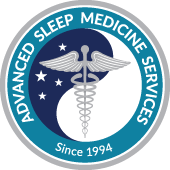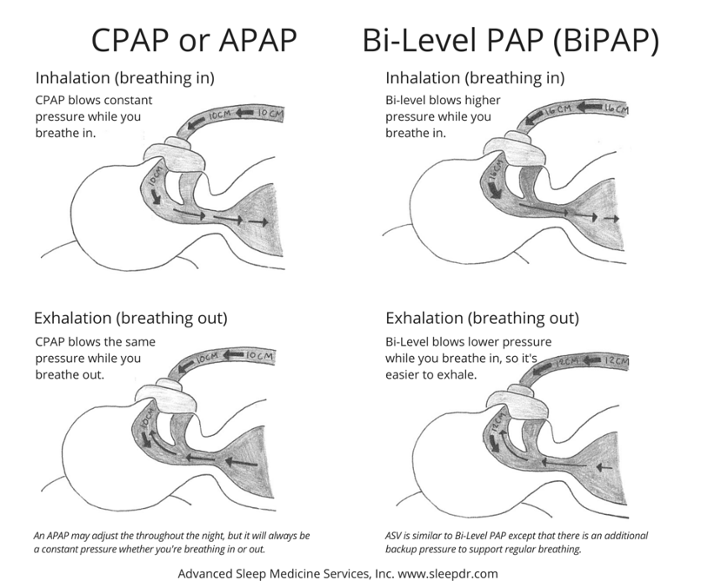It’s important to know the basic about the different types of PAP (positive airway pressure) devices that are used to treat sleep apnea. Whether you’re newly diagnosed with sleep apnea or a more seasoned user or healthcare provider, this post outlines the basics of each of the devices.
Our goal is to help you understand the differences in the devices or better understand the device you’re currently using. Ultimately, we want to help those who suffer from sleep apnea be successful with PAP therapy. Read on!
What is a CPAP machine?
Formal definition: CPAP, or Continuous Positive Airway Pressure, delivers pressurized ambient air (regular room air) through a delivery system (tubing and mask), thus eliminating apnea events during sleep. CPAP is the most effective treatment for sleep apnea and can potentially improve the patient’s sleep overnight; dramatically improving the quality of life for individuals afflicted with obstructive sleep apnea (learn about sleep apnea here).
What you need to know: CPAP is the most common PAP device. If you had a sleep study and a titration in a sleep center, this probably the type of PAP machine you will be recommended. Many sleep specialists agree that the fixed pressure is best for treating obstructive sleep apnea (we’ll talk about variable pressures later) and it’s the most affordable device.
What is an APAP or autoset PAP machine?
Formal definition: Auto titrating continuous positive airway pressure (autoPAP or APAP) machines are devices that are set at a variable pressure and adjust the pressure based on the patient’s needs using an internal algorithm. The pressure is monitored and adjusted breath to breath to treat the obstruction.
What you need to know: Since 2007, this device is become very popular after Medicare approved home sleep apnea testing (learn about that here). Some insurance companies are even denying requests for in-lab titrations in favor of APAPs (they want to save $$, learn about insurance coverage for sleep studies here). Here are the benefits and drawbacks of APAP:
Benefits:
(1) Having a device that can adjust its own pressure means that many patients can skip the sleep center altogether. These patients can use a home sleep apnea test and then an APAP. Easy peasy. No overnight at the sleep lab.
(2) APAP can be used immediately following a home sleep test for four to 6 weeks with a wide pressure range. Your healthcare provider can then assess the usage data to determine an optimal fixed pressure setting on a CPAP device.
(3) You can have a couple of beers, knowing it will make your sleep apnea worse that night, but rely on your APAP to adjust to your pressure needs (want to know if it’s OK to have a drink before your sleep study? Read this.)
Drawbacks:
(1) Not every patient can skip the sleep center or use an APAP. Patients with CHF (congestive heart failure), COPD (chronic obstructive pulmonary disorder), CO2 retention, daytime hypoxemia or obesity hypoventilation syndrome, should use a fixed pressure CPAP and have a titration in a sleep center (learn about different types of sleep studies here).
(2) The device works by sensing resistance in the upper airway and then delivering more or less pressure; however, it feels the airflow at the mask, not where the obstruction is actually happen in the airway, which increases the peak airway pressure that can increase risk of pulmonary complications (it’s a small chance, but important to consider). Additionally, there’s always a bigger chance of airleak. Mask fitting is extremely important with APAP.
(3) APAP may be more expensive than CPAP. Insurance companies don’t recognize a difference between CPAPs and APAPs as far as coverage is concerned. The CPT code is the same, E0601 and reimbursement varies by insurance company. Cash rates may vary greatly between the two devices as the APAP is a more advanced device and more expensive for your provider to purchase from the manufacturer (learn more about what PAP costs and what insurance will cover here).
Which is better: CPAP or APAP?
Formal answer: It depends. As discussed above, it’s only an option if you don’t have any of contraindications listed above.
But really, which is better? It really depends. Our chief medical officer, Said Mostafavi, MD has this to say:
Available data does not show any difference in efficacy between CPAP and APAP. There are several benefits of having a titration in a sleep center- like better mask fitting and patient education- but for many patients, especially those whose sleep apnea is diagnosed with HST, APAP could be considered. APAP could also be used during an in-center titration as well as being dispensed for a period of up to six weeks in order to determine fixed pressure and then be switched to CPAP.
What is a BiPAP or bi-level PAP machine?
Formal definition: BiPAP, or Bi-Level Positive Airway Pressure, is another form of sleep therapy, which delivers alternating levels of a higher inspiratory pressure (IPAP) to keep the airway open as a patient breathes in, and a lower expiratory pressure (EPAP) allowing the patient to exhale easily. Thus, a BiPAP is much easier for users with neuromuscular disease to adapt to. The dual settings allow patients to get more air in and out of the lungs without the natural muscular effort needed to do so.
Who can benefit from bi-level PAP?
(1) This device is usually recommended when the recommended CPAP pressure is really high and can be uncomfortable. Most insurance plans will cover it once the patient has tried CPAP in the lab and “failed” or did not tolerate CPAP. Because this machine is much more expensive than CPAP, insurance wants proof that it’s needed.
(2) Patients with neuromuscular disease who have difficulty breathing.
(3) Patients who have hypoxemia or retain CO2 at night.
(4) Patients who have aerophagia (excessive swallowing of air causing abdominal discomfort).
What is an ASV machine?
Formal definition: ASV is a BiPAP or bi-level PAP with a back-up rate. It is used primarily to treat central sleep apnea (CSA). ASV provides positive expiratory airway pressure (EPAP) and inspiratory pressure support (IPAP), which is servocontrolled based on the detection of CSA. The device provides a fixed EPAP determined to eliminate obstructive sleep apnea. The ASV device changes the inspiratory pressure above the expiratory pressure as required to normalize patients’ ventilation. With normal breathing, the device acts like fixed CPAP by providing minimal pressure support. When the device detects CSA, the device increases the pressure support above the expiratory pressure up to a maximum pressure.
Recent studies show that ASV isn’t for everyone: ASV therapy is contraindicated in patients with chronic, symptomatic heart failure (NYHA 2-4) with reduced left ventricular ejection fraction (LVEF ≤ 40%) and moderate to severe predominant central sleep apnea. These patients may benefit from BiPAP or bi-level PAP and low flow oxygen. For more information, see the study links at the end of this post.
What are the complications of PAP therapy?
Regardless of the device type you use, there are things to keep in mind:
(1) Irritation on the bridge of the nose caused by the mask and headgear (learn more about different types of masks here).
(2) Irritation of the eyes (dryness or even conjunctivitis) from mask leak. Proper mask fitting is very important.
(3) Irritation of the airways. Especially in dry climates, for older patients or patients taking medications that dry the sinuses. Heated humidification will alleviate this.
(4) Aerophagia (excessive swallowing of air causing abdominal discomfort).
How can I order a new machine?
First, you’ll need a sleep study (learn more about that process here). If you’ve already been diagnosed with sleep apnea, you will need to find a provider, usually a DME (durable medical equipment) provider or HME (home medical equipment) provider. We are contracted with all major PPOs and many medical groups in California. To see if we are contracted with your insurance, see our list here.
Sources:
http://www.sleepreviewmag.com/2010/10/aerophagia/
http://www.eurekalert.org/pub_releases/2016-05/esoc-ego051916.php
http://www.aasmnet.org/articles.aspx?id=5562
Other posts you may find interesting:
- What is the difference Between Nasal, Nasal Pillows, and Full-Face Masks?
- What is the Difference Between Disposable and Nondisposable or Reusable CPAP Filters?
- How Often Should You Replace Your CPAP Supplies?
- Will my Insurance Cover CPAP? Frequently Asked Questions About Coverage
- Sleep Apnea Patients Must Show PAP Compliance Before Device Purchase or Resupply



Comments
FAZAL SUBHAN
Posted on January 12, 2017Hi,Madam, My name is Fazal Subhan from karachi pakistan, I am sleep apnea patient and doctor advised me to take cpap macine for breathing at night sleep. unfortunately I can not afford this expensive machine, so please if you have some special relief for needy people than help me. I am very thankful to you. God bless you. thank you very much
Julia Rodriguez
Posted on January 17, 2017Hi Fazal. I suggest contacting the organizations listed in this post: http://malaga.temp.domains/~sleepdr/the-sleep-blog/help-i-cant-afford-cpap-where-to-find-low-cost-or-free-cpap-machines-and-supplies/ They should be able to help you find free or low cost supplies or a machine. Good luck! Please let me know if you end up working with another organization not listed here so that I can update the list.
john Watkins
Posted on January 27, 2017Hi my name is John Watkins my bipap machine went out i can not afford the dedutable my instance wants me to pay for new machine…I’ve recently has an amputation and my wife had cancer..we are behind due to in the only provider. Is there someplace in Iowa that helps people in need…i live by des Moines…
Julia Rodriguez
Posted on February 01, 2017Hi John. We have a list of organizations that can provide you with free or low-cost equipment and supplies here: http://malaga.temp.domains/~sleepdr/the-sleep-blog/help-i-cant-afford-cpap-where-to-find-low-cost-or-free-cpap-machines-and-supplies/ Good luck!